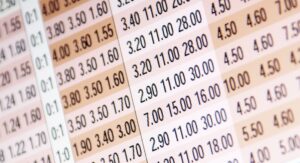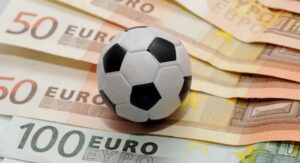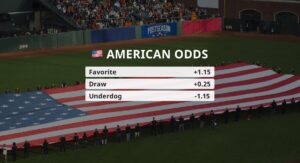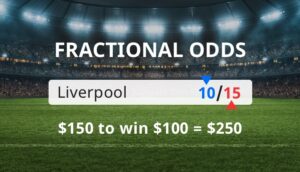Understanding Probability, Odds and Overround (Vig)
Most people understand that the amount of winnings you get from a successful bet is dependent on the odds available and the amount you staked. But the majority do not fully understand or take into account what the bookmakers’ odds actually represent.
Contrary to popular belief, they are not randomly plucked out of thin air, but instead carefully calculated numbers to ensure that the bookies’ always have the edge over us poor punters in order to take our hard-earned cash.
Read on to learn more about probability, odds and overround (vig).
Bookie of the Month
A Beginner’s Guide to Odds and Probability
To fully understand how to make consistent profit from the bookmakers, it makes sense to fully understand what all of the numbers actually mean when you log in to your betting account.
In the simplest of terms, odds represent the chance of something happening (let’s call this an outcome) within a wider something (let’s call this an event).
So odds indicate the chance – or probability – of an outcome happening within an event, with all outcomes within that event adding up to 100% to make sure every eventuality is covered.
Two simple examples to demonstrate the point are tossing a coin and rolling a dice:
- Tossing a coin will produce two outcomes of equal probability – a 50% chance of heads and a 50% chance of tails.
- Rolling a dice will have six possible outcomes of equal probability – 16.66% chance of a 1, 16.66% chance of a 2, 16.66% chance of a 3, 16.66% chance of a 4, 16.66% chance of a 5 and 16.66% chance of a 6.
Not all outcomes will have an equal probability of occurring though.
If we took a loaded dice rather than a fair dice, one of the outcomes would have an increased probability of happening compared to the other five outcomes because it is weighted.
With a loaded dice, you may find that the probability or chance is actually more like (again noticing that all outcomes add up to 100%):
- Rolling a loaded dice will have 6 possible outcomes of unequal probability – 14% chance of a 1, 14% chance of a 2, 30% chance of a 3, 14% chance of a 4, 14% chance of a 5 and 14% chance of a 6.
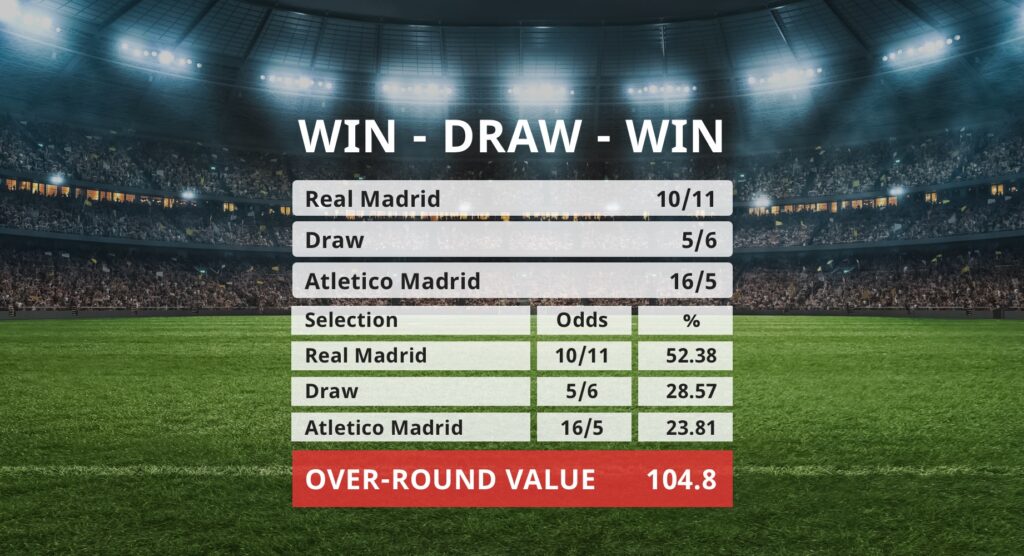
Sports Betting Odds Formats
Rather than display probability, bookmakers convert it into odds to reflect the chance of an outcome happening. Odds can be expressed as Decimal (2.50), Fractional (1/1) or American (+100) depending on your preference, location and sport you bet on:
- Decimal – Also known as European, Decimal odds show the total amount you will receive if your bet wins, including your initial stake. So for every $1 you stake at odds of 2.50, you will receive $2.50 back. E.g. if you bet $100 on odds of 2.50, you will return $250 of which $150 is profit (profit = $250 return – $100 stake)
- Fractional – Also known as Traditional or British, Fractional odds show the amount of profit relative to your stake if your bet wins. So for every $1 you stake at odds of 3/1, you will receive $3 profit and your $1 stake back. E.g. if you bet $100 on odds of 3/1, you will return $400, made up of $300 profit and your initial $100 stake.
- American – Also known as US or Moneyline, American odds have two possibilities and can be expressed as either + or -. For positive figures, the odds quote how much money you will win on a $100 stake, and for negative figures, the odds show how much needs to be staked in order to win $100. E.g. if you bet $100 on odds of +250, you will return $350 made up of $250 profit and your $100 initial stake. If you bet $200 on odds of -200, you will return $300 which is made up of $100 profit and your initial $200 stake.
It can be a bit of a hassle to convert between the different types of odds. Luckily, we have developed a converter. You can go to this page; SBO Odds Converter.
For those wanting to understand the relationship between the three types of odds, the below table gives the calculation:
| Fractional to Decimal | Moneyline to Decimal | Fractional to Moneyline |
|---|---|---|
| Divide the left-side of the fraction by the right-side, then add 1. (L / R) + 1 | If the odds are positive, divide by 100 and add 1. (+ML / 100) + 1 | Divide the big number by the small number, then multiply by 100 or -100 depending on which side of the bracket the big number is on. (B / S) x 100 or (S / B) x -100 |
| For odds of 5/1, divide 5 by 1 then add 1. (5 / 1) + 1 = 6 | For odds of +230, divide by 100 then add 1. (230 / 100) + 1 = 3.3 | For odds of 3/1, divide 3 by 1 then multiply by 100. (3 / 1) x 100 = +300 |
| For odds of 1/5, divide 1 by 5 then add 1. (1 / 5) + 1 = 1.20 | If the odds are negative, divide 100 by the Moneyline amount (taking off the minus) and add 1. (100 / ML) +1 | For odds of 1/3, divide 3 by 1 then multiply by -100. (3 / 1) x -100 = -300 |
| For odds of -280, divide 100 by 280 then add 1. (100 / 280) + 1 = 1.36 |
With all of this talk of different types of odds and how to convert them, let’s not forget the key point: odds represent probability.
No matter which type of odds you use, they are just the way that bookmakers provide the punter with different probabilities of outcomes happening within an event, be it a horse race, football match, baseball game or curling.
It makes sense that if something is more likely to happen, the probability, and therefore the odds, will be smaller than something that is very unlikely to happen.
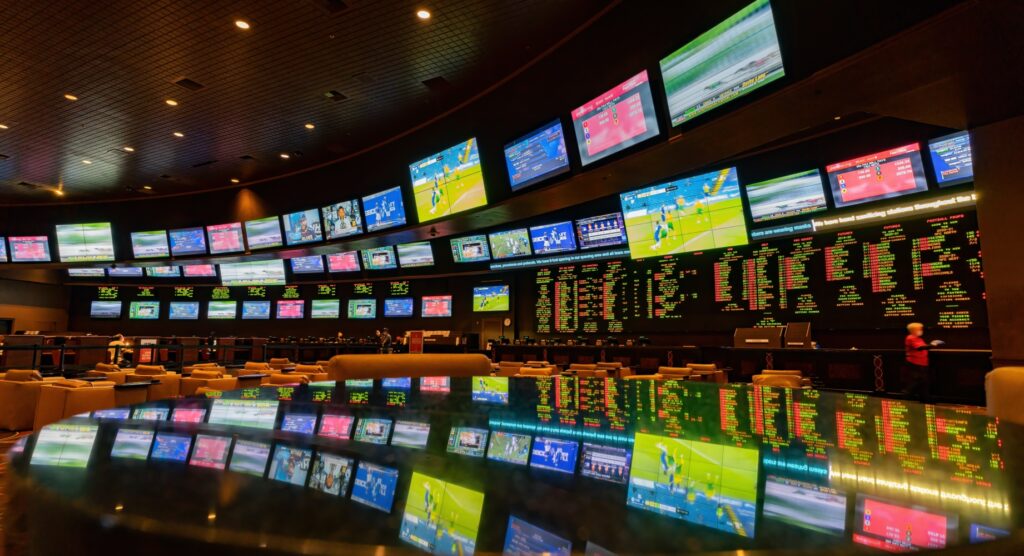
Determine the Probability Set by Bookmakers
To fully understand what the odds are saying, it is sensible to determine the probability set by bookmakers.
To do this, use the simple calculation of 1 divided by the decimal odds, multiplied by 100.
(1 / Decimal Odds) x 100
The below table shows examples of the probability of an outcome happening with the associated decimal, fractional and moneyline odds.
| Probability | Decimal Odds | Fractional Odds | Moneyline Odds |
|---|---|---|---|
| 99% | 1.01 | 1/100 | -10000 |
| 83.3% | 1.25 | 1/4 | -400 |
| 66.7% | 1.50 | 1/2 | -200 |
| 57.1% | 1.75 | 3/4 | -133.3 |
| 50% | 2.00 | 1/1 | +100 |
| 40% | 2.50 | 3/2 | +150 |
| 33.3% | 3.00 | 2/1 | +200 |
| 20% | 5.00 | 4/1 | +400 |
| 10% | 10.00 | 9/1 | +900 |
| 2% | 50.00 | 49/1 | +4900 |
| 1% | 100.00 | 99/1 | +9900 |
| 0.02% | 500.00 | 499/1 | +49900 |
As an example, the chance of an unseeded player (A) winning his first tennis tournament is going to have long odds due to the unlikeliness (e.g. decimal odds of 800.00), compared to the number 1 seed (B) who has won the last two consecutive tournaments and is seen as the favourite (e.g. decimal odds of 2.75).
To better understand the chance that these two players have of winning the tournament, it is sensible to determine the probability.
- For Player A, the probability is (1 / 800) x 100 = 0.125%
- For Player B, the probability is (1 / 2.75) x 100 = 36.36%
The bookies have Player A as having a 0.125% chance of winning the tournament whilst Player B has a 36.36% chance. You’ll notice that the sum of Player A and Player B only reaches a probability of 36.485% which is less than 100%. This is because we are only looking at two outcomes in the event (Player A or Player B winning the tournament) rather than every possible outcome (all players taking part in the tournament will have a percentage chance of winning).
If we looked at Player A and Player B facing each other in a match, we may find the odds, and therefore probability, are more along the lines of 1.025 ( 97.56%) and 17.0 (5.88%). But wait, you just said everything needs to add up to 100%, didn’t you?
Yes – this is where the bookies’ make their edge, also known as the overround, and ensure that the majority of punters don’t make money in the long term. If the bookies’ probabilities added up to 100%, there would be no money in it for them. Instead, they make all outcomes in an event total greater than 100% so they can take a margin. In this case, their edge is 3.44%.
The overround makes sure that the true odds (which add up to 100%) are replaced by the bookmakers actual odds (100% + the overround), so that any winners are paid out at a reduced rate than the actual probability suggests.
As a ‘fun’ experiment to demonstrate this, go to any football match and look at the odds of a home win, draw and away win. The match I looked at has the following decimal odds:
- Home win = 1.85
- Draw = 3.6
- Away win = 4.75
Working out the probability for these odds using (1 / Decimal Odds) x 100 shows the following results:
- Home win = 1.85 (54.05%)
- Draw = 3.6 (27.78%)
- Away win = 4.75 (21.05%)
Adding up the likelihood of these three outcomes gives a total probability of 102.88%, which is above 100%. This means that the bookmaker has added a 2.88% overround to their book. If the bookmaker received stakes from punters in the same proportion to his book, they would bring in 102.88 units but only ever have to pay out a maximum of 100 units, meaning that they have made themselves a profit of 2.88 units.
Dependant on the amount of money coming into the book, you will see that odds fluctuate in order for the bookmaker to balance their book and ensure they keep an overround present. If the home win is heavily backed, you may see the odds in the example above drop to 1.75 (57.14%) whilst the odds on the away win are pushed out to 4.85 (20.62%) to attract more money in order to balance the books – in this case, the overround would have increased to 5.54%
Conclusion
This article isn’t intended to give a comprehensive description of how the leading sports betting sites set their odds and balance their books.
Instead, it is intended to give an insight into why understanding odds is important and to acknowledge that the bookmakers have you over a barrel before you’ve even placed a bet through the use of an overround!
The next step, which will be talked about in a later article, is understanding how you can set your own odds based on your own calculated probabilities to identify where you believe the bookmakers have provided higher odds that you’d expect, thus finding ‘value’ in the market.



